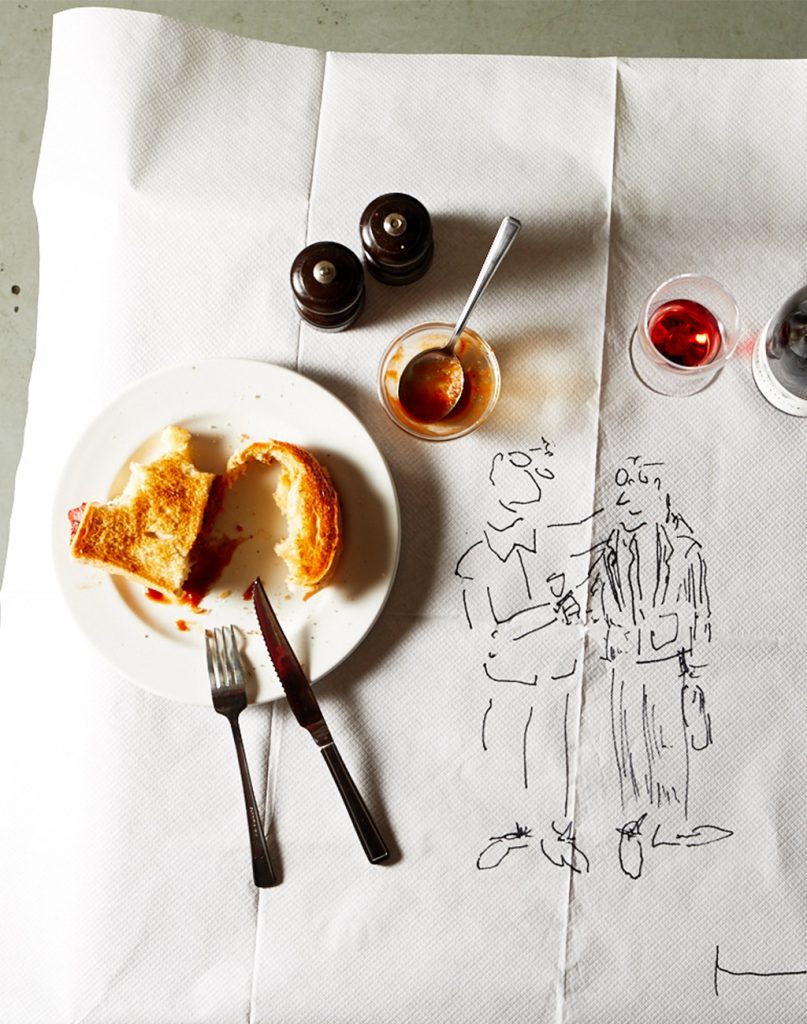
in Art
Tasya Van Ree
"I really try to exist in my own energetic field."

Canonised for their offal-laden philosophy of nose-to-tail eating, chef Fergus Henderson and his business partner Trevor Gulliver are the men quietly responsible for heralding a global revolution of intrepid eating. Praised as a prophet of English cuisine, the founders of St. John restaurant speak on the sanctity of lunch, the joys of eating, and the food that brings us around the table time and time again.


Lunchtime prickles with possibility on a Friday afternoon along the cobbled streets of South London’s famous Maltby Street Market. We have arrived at St John, a legendary British institution helmed by the renowned chef Fergus Henderson. This afternoon, the softly spoken chef stands resplendent in his signature pinstripes as preparation for the lunch service unfolds around him. Buttery toast glistens with bacon dripping, marrow sizzles on hunks of bone, and the bakery’s notorious sugar dusted donuts arrive in a pillow tower, oozing jam and custard. Trestle tables scrape against the stone, chairs are whisked into place, and the scene is set. Unlike the short-stop of dinner trussed in its formalities and the inevitable late evening slump, lunch is a firework waiting to go off; an open invitation for fun. For the founders of St. John, lunch presents itself as a happy meeting point for friends, food and unfettered conversation. Over plates of devilled kidneys, thick- cut bacon sandwiches, slabs of foie gras and generous slugs of pinot noir, the double-act muse on the delightful pleasures of food and company on a crispy spring day.
The moment I wake up with my head on the pillow, I start thinking about lunch. It’s bliss to have lunch.
Fergus Henderson
Fergus Henderson: At 12 o’clock when the doors open, you don’t know who’s coming or how many people. By one o’clock, the tables are humming with the excitement of lunch. By the evening, the tables are have not quite stopped humming, but the spirit of lunch is transferred and then magnified by a light supper. Good food brings people together, but do not think only of food – remember the importance of napkins and tablecloths. The texture of a crisp napkin, the feeling of being nurtured, the anticipation. That can create great electricity in a gathering.
Trevor Gulliver: The restaurant is part of an occasion, neighbourhood, a vital part of the streetscape. A good restaurant is a joy to go back to because it holds memories, it’s a treat. For us at St. John we count a regular as someone who comes back once a year, not just the people who are here three or four times a week.
FH: You can’t look forward to a sandwich and coke. It’s no way to live- it’s no way to have a lunch, no way to be inspired to design! The moment I wake up with my head on the pillow, I start thinking about lunch. It’s bliss to have lunch.
TG: Yes, lunch is important. Perhaps the first conversation we have is, where are we having lunch? And in fact, when you’re travelling, lunch is often better than dinner. Not that dinner is bad! Lunch is just much more engaged with the day and where you are. Dinner is a bit like going to the cinema. It’s a different type of experience, the conversation is always different at lunch.
TG: We don’t do visions or concepts, and we don’t like artifice. We like people to enjoy themselves and understand what a good lunch is. That is very important. We were never a concept. ‘Nose to Tail’, that’s Fergus’ gift to the written word.
FH: It seems to be common sense, it’s so dull. It’s using the whole beast and enjoying the library of the fillet. Tasty, delicious things.

FH: Good food is a permanent thing. There are moments when it is more appropriate to cook something particular, rather than other things. Seasons for example; good old nature provides the rigour of the seasons and we should celebrate these moments of abundance. When there is an abundance of a particular ingredient, they are at their tastiest. We should eat runner beans, say, every day, then make chutney from them as they grow up. Then when they go too stringy, stop eating them all together and look forward to the next year. Location is vital when it comes to good food.
FH: It really is extraordinary how avocados have become the breakfast of choice. The genus loci is strong with food and its consumption. Though supermarkets, the evil empire, want you to eat strawberries all year round. With this approach, there is no sense of place. They would have you think that it is not to do with flavour, but rather that it is how red they look, which only shows how easily led we are.
On a rather controversial note, Elizabeth David has rather a large part to play in all this- writing about the Mediterranean with its sun-ripened tomatoes and bushes of basil, painting a picture of a culinary idyll not obtainable in the grey, cold British isles. She created an appetite for things that could not be fulfilled without unhappy compromise. In short, I am not convinced by cooking without season or appropriate location. The world is small now and ingredients will travel, but who wants to eat something that has more air miles than the average businessman? Just think, you can drink gallons of local rosé on holiday, but take it home and it is undrinkable. This is the power of place. Of course, I am not being jingoistic, and I know that ideas do travel too! But in short, nature writes your menu and you should listen.
FH: Seed cake and Madeira at eleven o’clock. I am at St John’s most days having seed cake and a glass for my elevenses, and there is an open invitation to all to join me for this moment of sustenance. I evidently misjudge my friends- every day I expect a better turn out, but it seems that folk are not ready for the mid-morning festive moment. This is not to say you have to go crazy. Compare it to a firework: a short invigorating moment of cake, and the symbiotic Madeira wine, then it is over but leaves you happy and satisfied until the next excitement – lunch! Every aspect is inspired by a good lunch.
FH: My mum was a cook and my dad more of an eater. It’s strange, my bonding with food. I remember on my wedding night with Margot, she fell asleep, and so I kept eating!
TG: I think we were both born dead with a glass in our hand.
TG: With Fergus and I there’s no yin-yang, it’s more, “now it’s your turn to come up with something new.”
FH: After all these years, I have finally driven him to yoga.
TG: Yes, Fergus finds it very unnerving the idea of me spending my time crossed legged and chanting. But I’ve always been enchanting.
FH: On my perfect day, I would start with lunch at Sweetings. The thought of the reassuring mosh pit of people waiting for tables as you enter! The happy scrum. I’ll start with a Black Velvet at the bar, served in a silver tankard which imparts a metallic tang to the drink. Then, when I have been seated by Angelo (the waiter who also served my father), I will order a bottle of Chablis and a plate of plaice, chips, and peas. I am a creature of habit… although I used to order scampi, not plaice, so there has been a little change. An emotional step!
Lunch is like a springboard, it can take you to places you never expected to go. So, then I would then hop on the Eurostar for a refreshing nap and wake up in Paris. After checking in at L’Hotel, requesting the room at the top, I would go straight to La Pallette for a pastis, to get my cultural bearings. Then dinner at Le Grand Véfour, which is the most beautiful room ever. It does great things for the spirit. I made the mistake once of ordering pigeon stuffed with foie gras and truffles, which was so rich that I felt it for days. So now I order two starters instead. The same thing for both courses: a sea urchin baked encocette with quail’s egg and caviar. As I walk back through the glittering Paris Royale, all sparkling lights and romance, I would feel that it was a day well spent.
TG: Immaturity, naivety, experience, and understanding, and then enlightenment…no and then lunch!
The son of two architects, Fergus Henderson originally studied architecture before his thoughts turned to cooking. After running The French House Dining room with his wife Margot, he met Trevor and opened the now legendary St. John in Smithfield. Since 1995, St. John has grown to include three restaurants, a bakery, a winery and a wine company. Over the years they have won numerous accolades including, Best British and Best Overall London Restaurant at the 2001 Moët & Chandon Restaurant Awards. After being awarded an MBE for services to gastronomy, Fergus was celebrated with The Diner’s Club Lifetime Achievement Award in 2014.
Follow St John Restaurant:
Website: www.stjohnrestaurant.com
Instagram: @st.john.restaurant

Article from the issue :